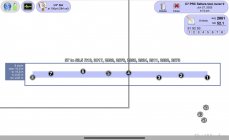222Jim
Silver $$ Contributor
I'm a little stumped and hoping for some feedback.
I took my .308 out last week for the first time this year. I'm just starting load development and last fall zeroed the rifle at 100 meters at a charge that gave me a velocity of ~2,625 fps. Late last week I went out to do a powder charge ladder - I loaded and fired 10 shots at each step for a total of 100 shots. Each ladder rung was 0.50 gr apart. Mean radius for all 100 shots averaged 0.23 MOA, with promising 10 shot loads showing a mean radius of 0.13 MOA (and "less promising" 0.38 MOA).
But.............
There is an almost perfectly linear pattern between velocity (charge) and group center, with the group center very visibly getting lower and lower as velocity increases. Why?
I've done some online research and the most common explanations I find are (1) the muzzle has more time to jump up further at lower velocities before the bullets exits, and (2) barrel harmonics. I'm skeptical, in part because I'd expect muzzle jump to be somewhat erratic if caused by my poor form, hence leading to poor groups. But, the smaller/better groups are at lower velocities, with the best at ~2,325 fps (i.e., the slowest). And I can't imagine, given how small barrel harmonic movement is, that's the cause.
Any thoughts or opinions on what's going on?
FYI - Rifle a Bergara HMR Pro, and loads consist of Lapua brass, Varget, Sierra 168 MatchKing bullets, and Federal Gold Medal Large Rifle primers.

I took my .308 out last week for the first time this year. I'm just starting load development and last fall zeroed the rifle at 100 meters at a charge that gave me a velocity of ~2,625 fps. Late last week I went out to do a powder charge ladder - I loaded and fired 10 shots at each step for a total of 100 shots. Each ladder rung was 0.50 gr apart. Mean radius for all 100 shots averaged 0.23 MOA, with promising 10 shot loads showing a mean radius of 0.13 MOA (and "less promising" 0.38 MOA).
But.............
There is an almost perfectly linear pattern between velocity (charge) and group center, with the group center very visibly getting lower and lower as velocity increases. Why?
I've done some online research and the most common explanations I find are (1) the muzzle has more time to jump up further at lower velocities before the bullets exits, and (2) barrel harmonics. I'm skeptical, in part because I'd expect muzzle jump to be somewhat erratic if caused by my poor form, hence leading to poor groups. But, the smaller/better groups are at lower velocities, with the best at ~2,325 fps (i.e., the slowest). And I can't imagine, given how small barrel harmonic movement is, that's the cause.
Any thoughts or opinions on what's going on?
FYI - Rifle a Bergara HMR Pro, and loads consist of Lapua brass, Varget, Sierra 168 MatchKing bullets, and Federal Gold Medal Large Rifle primers.












